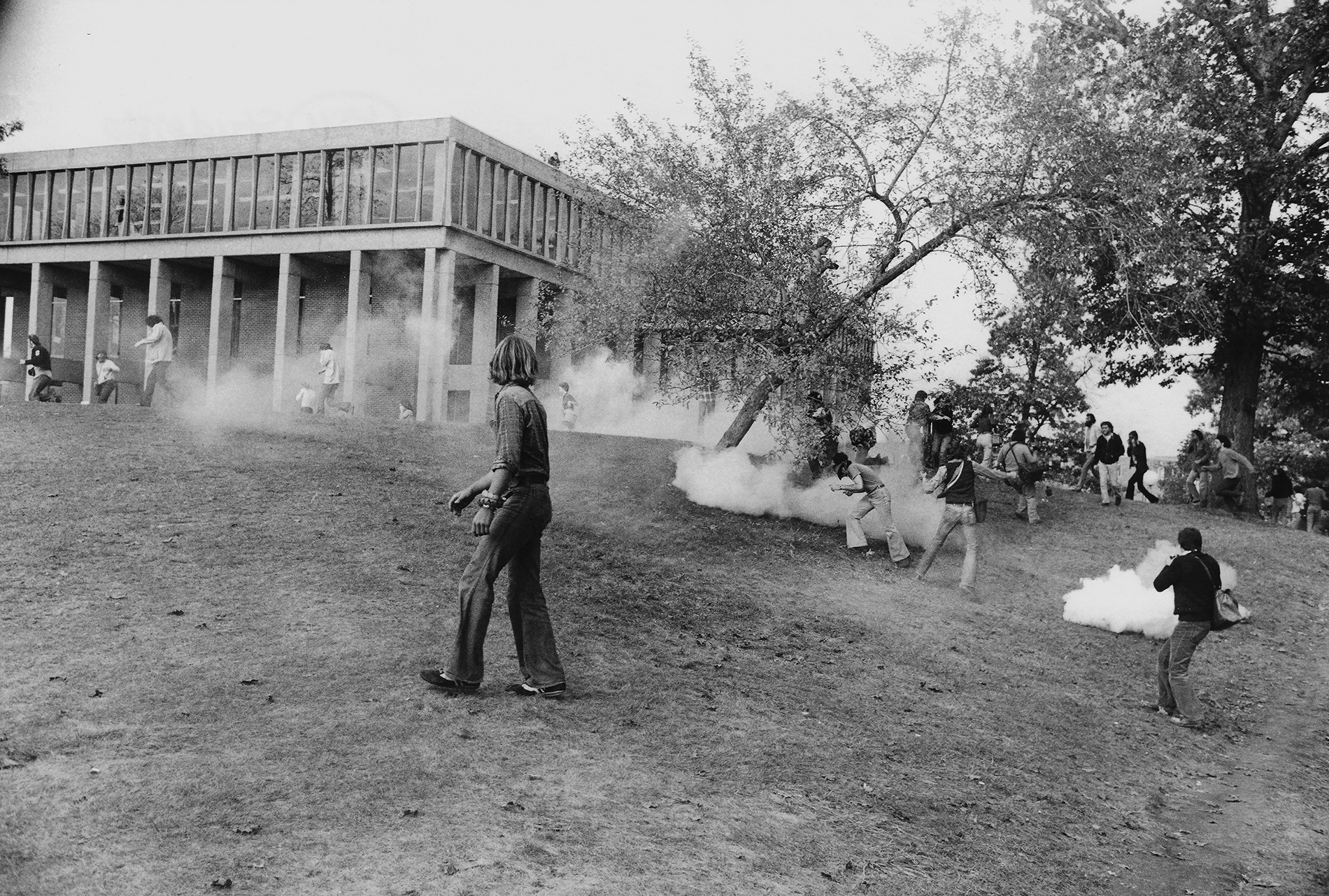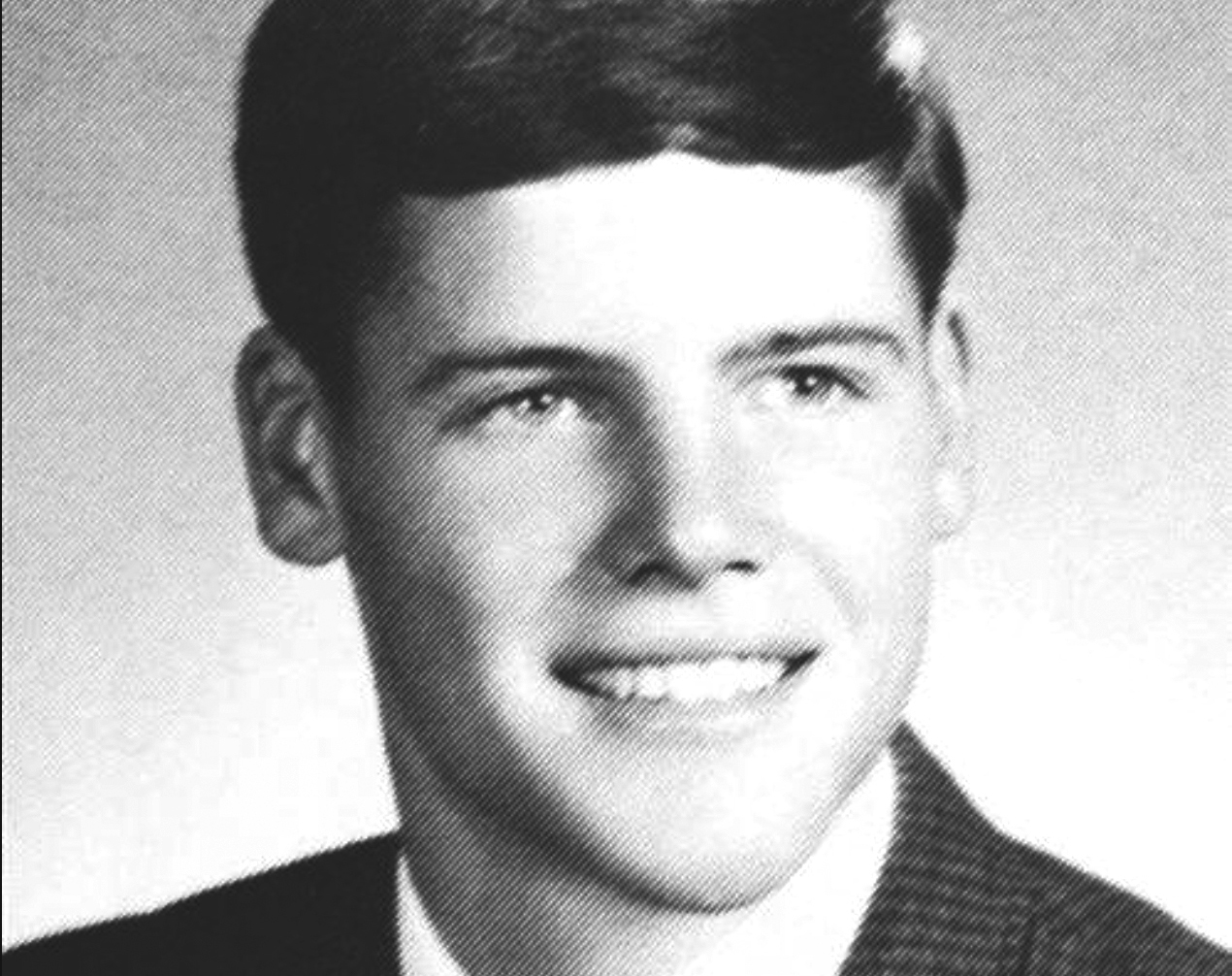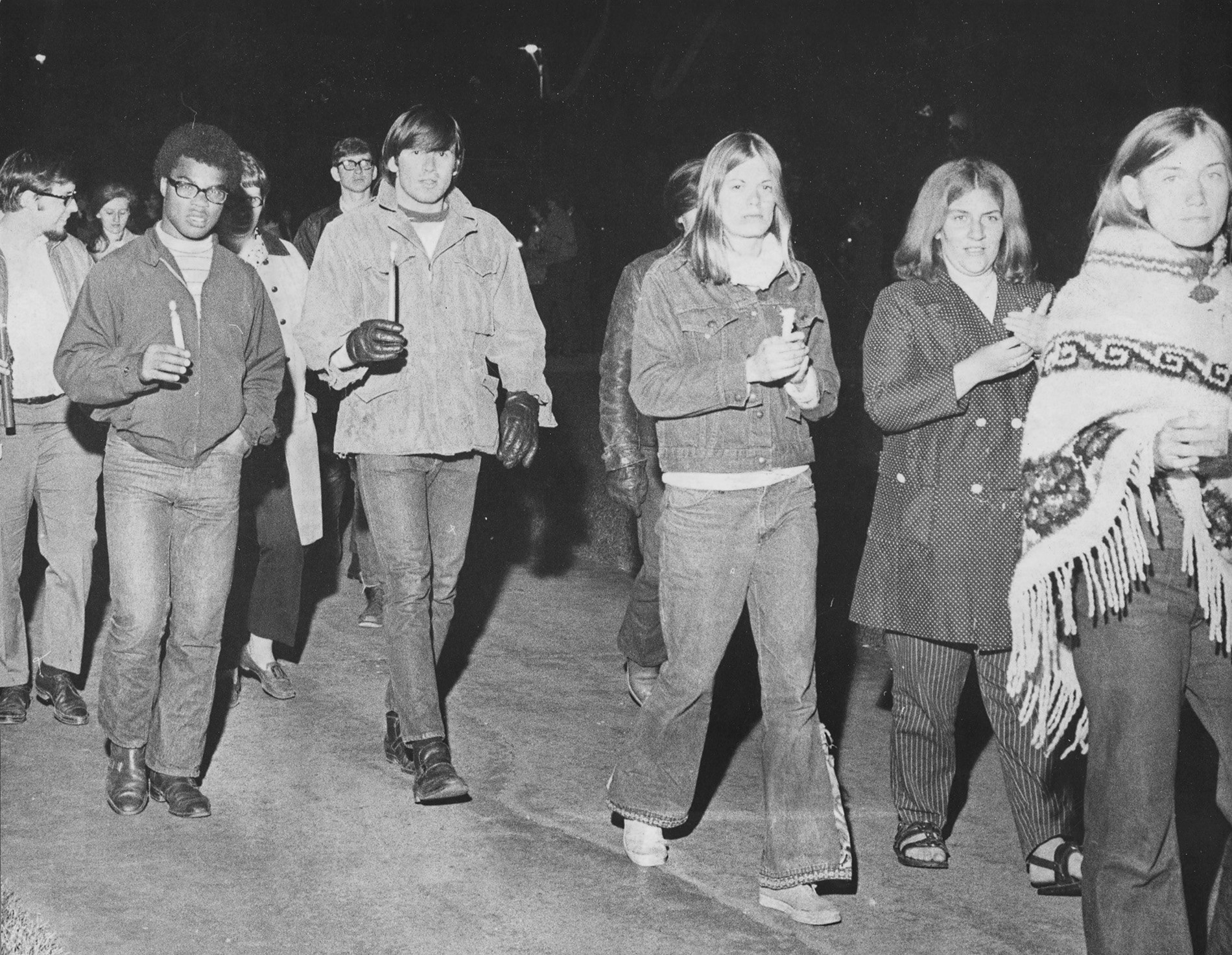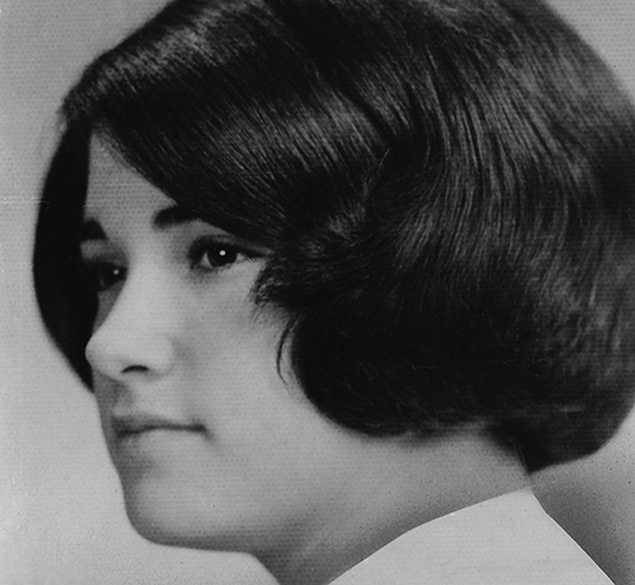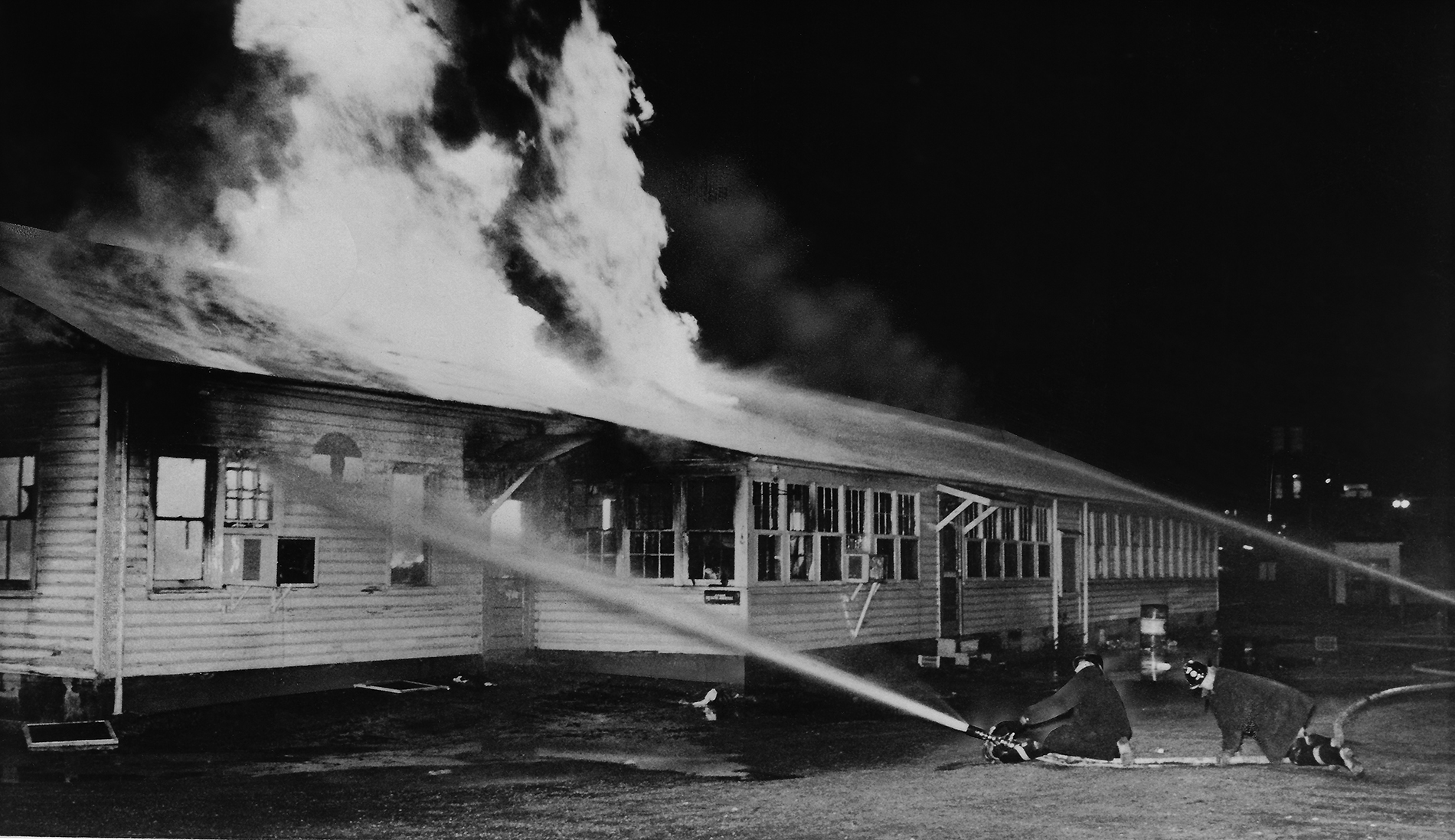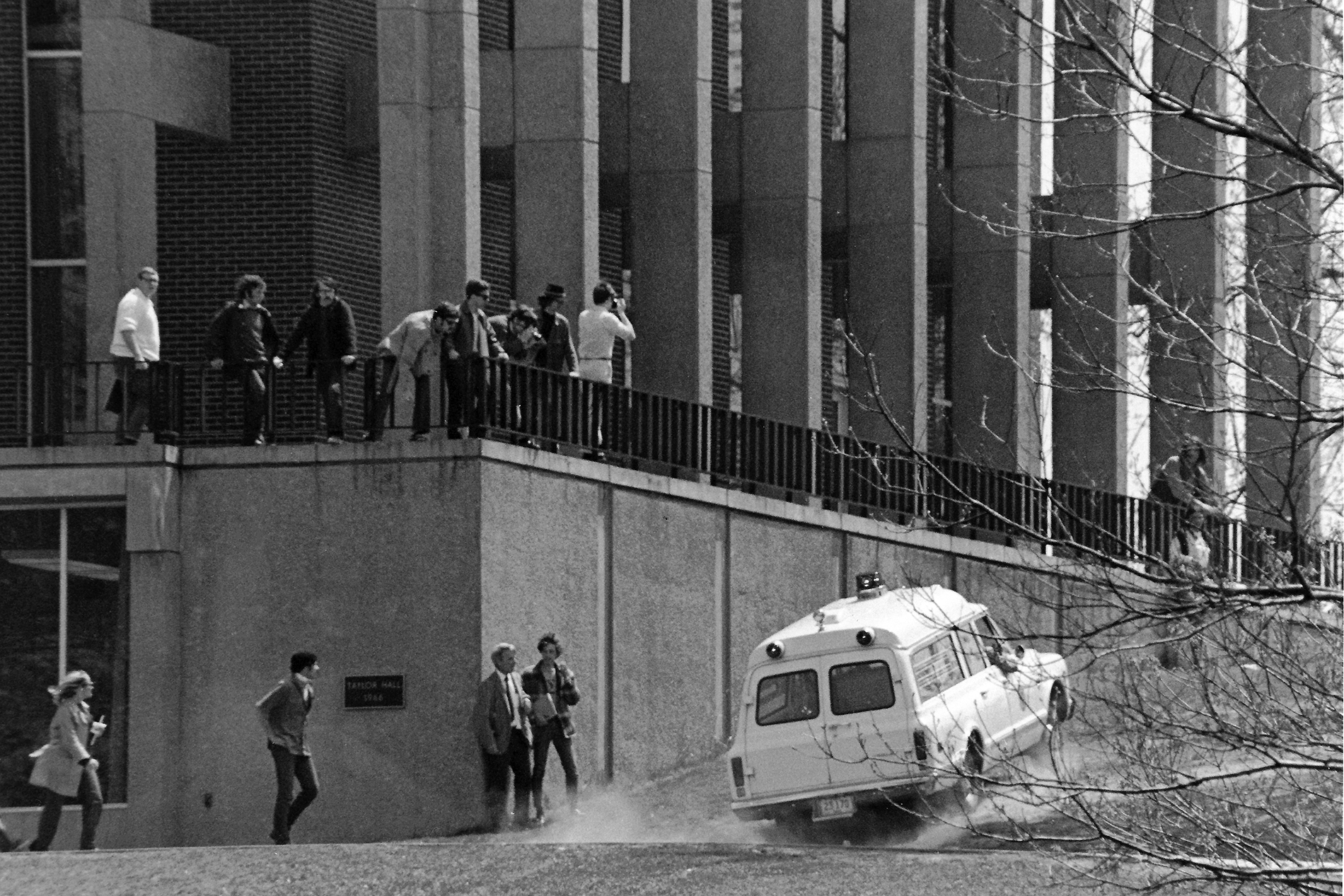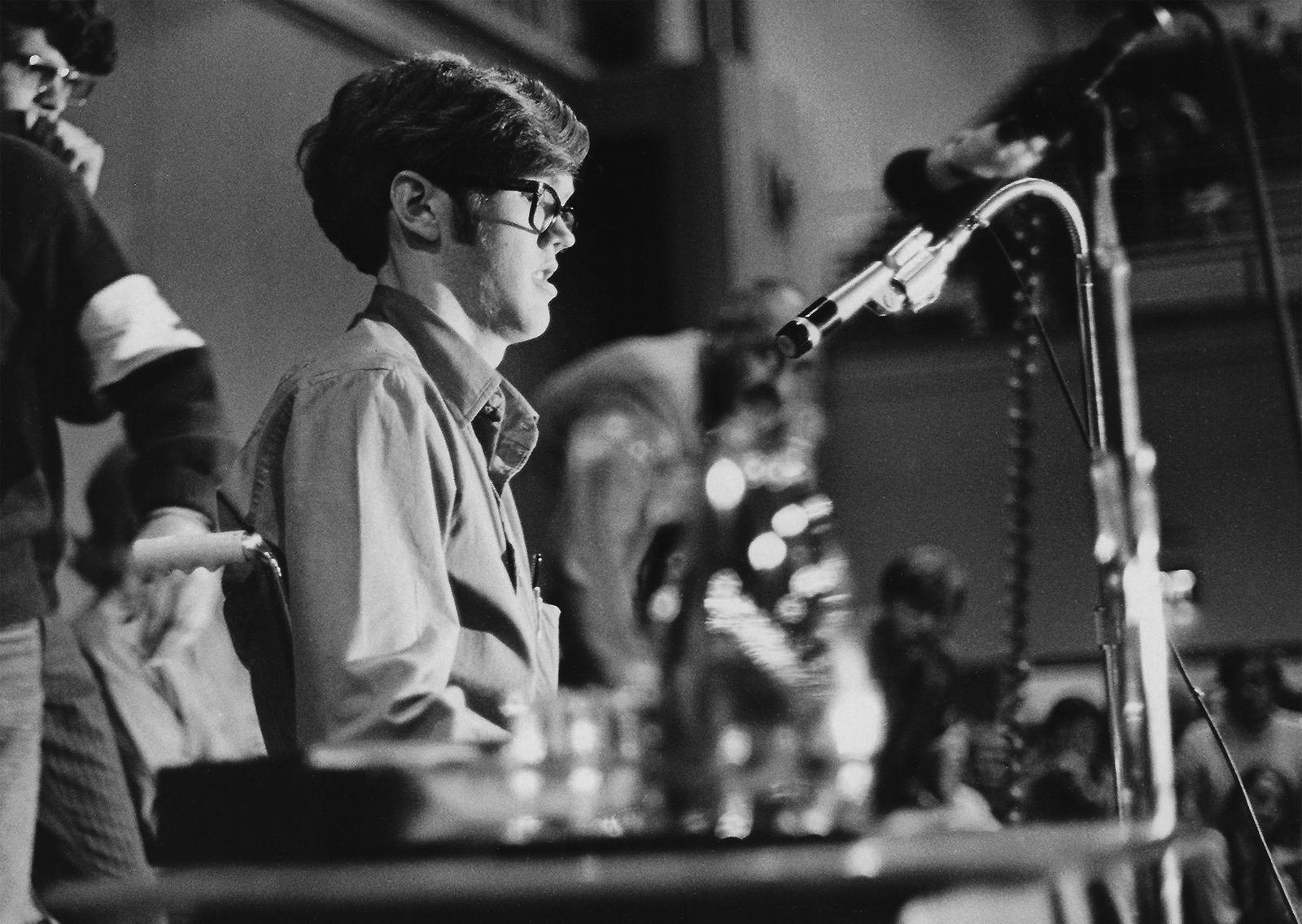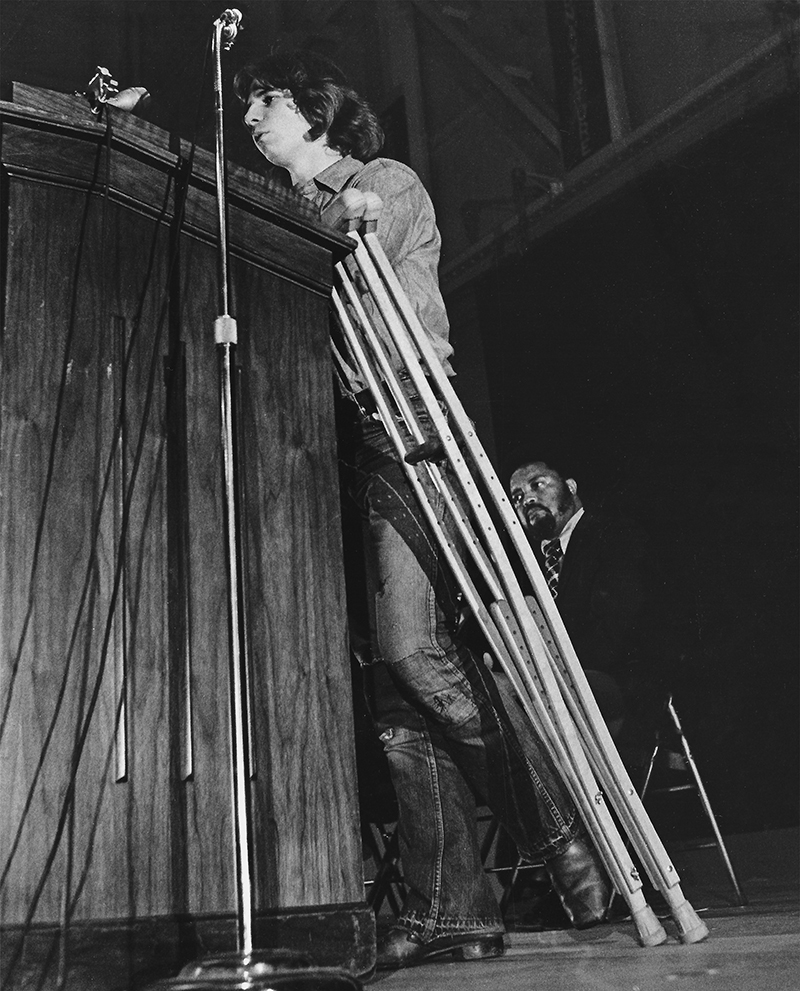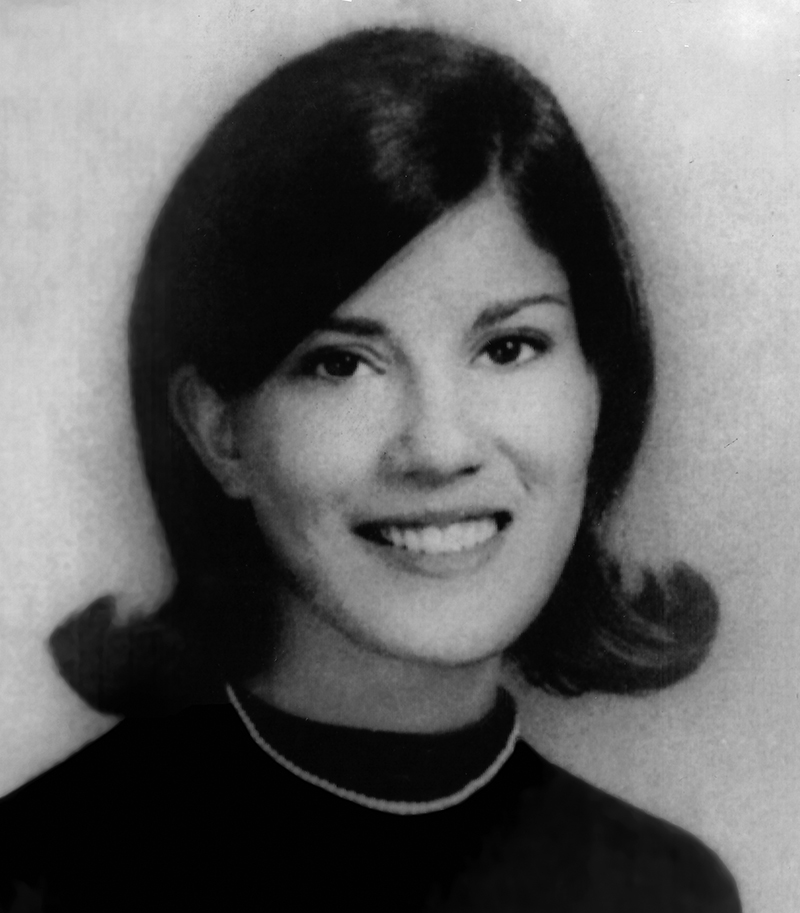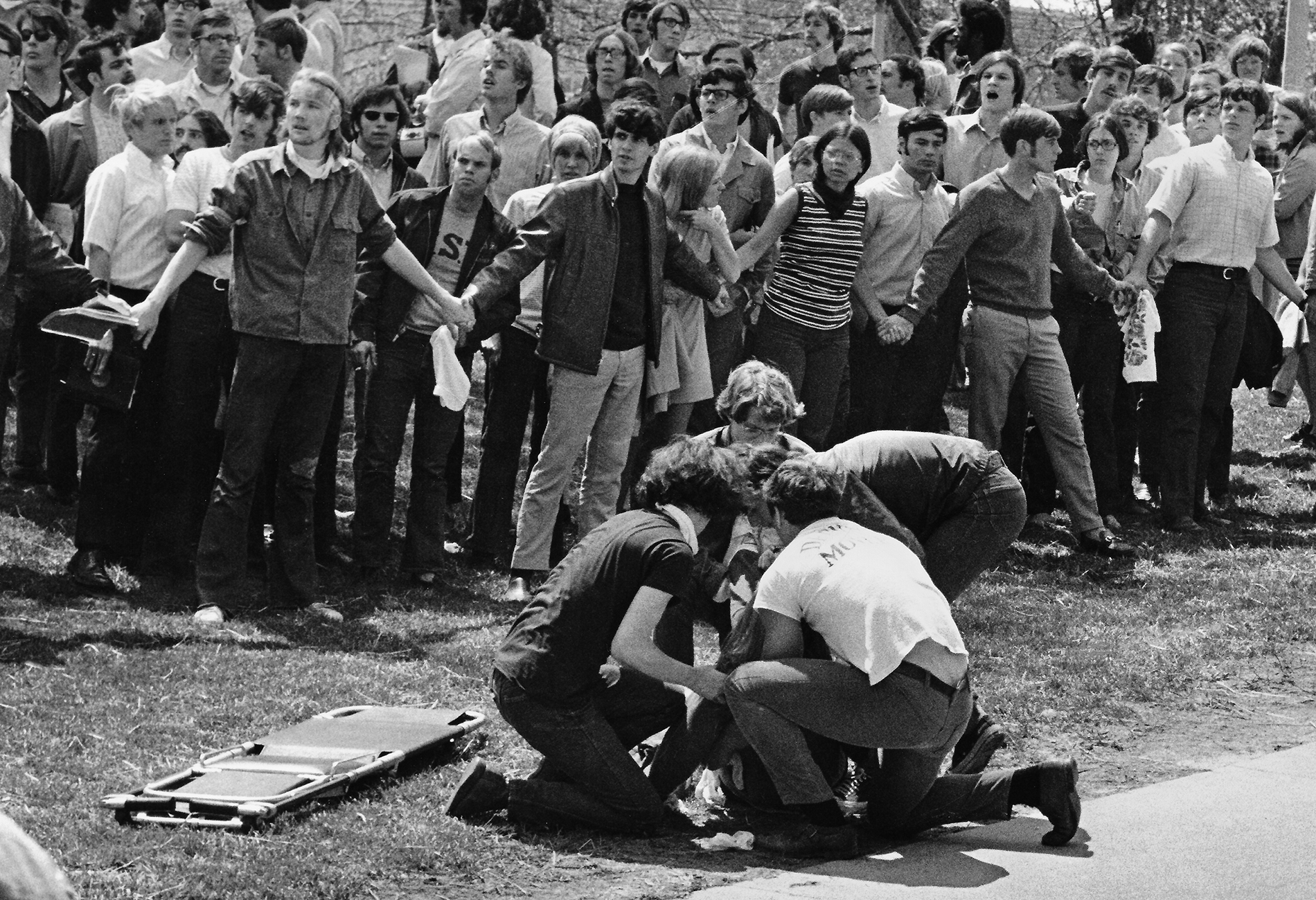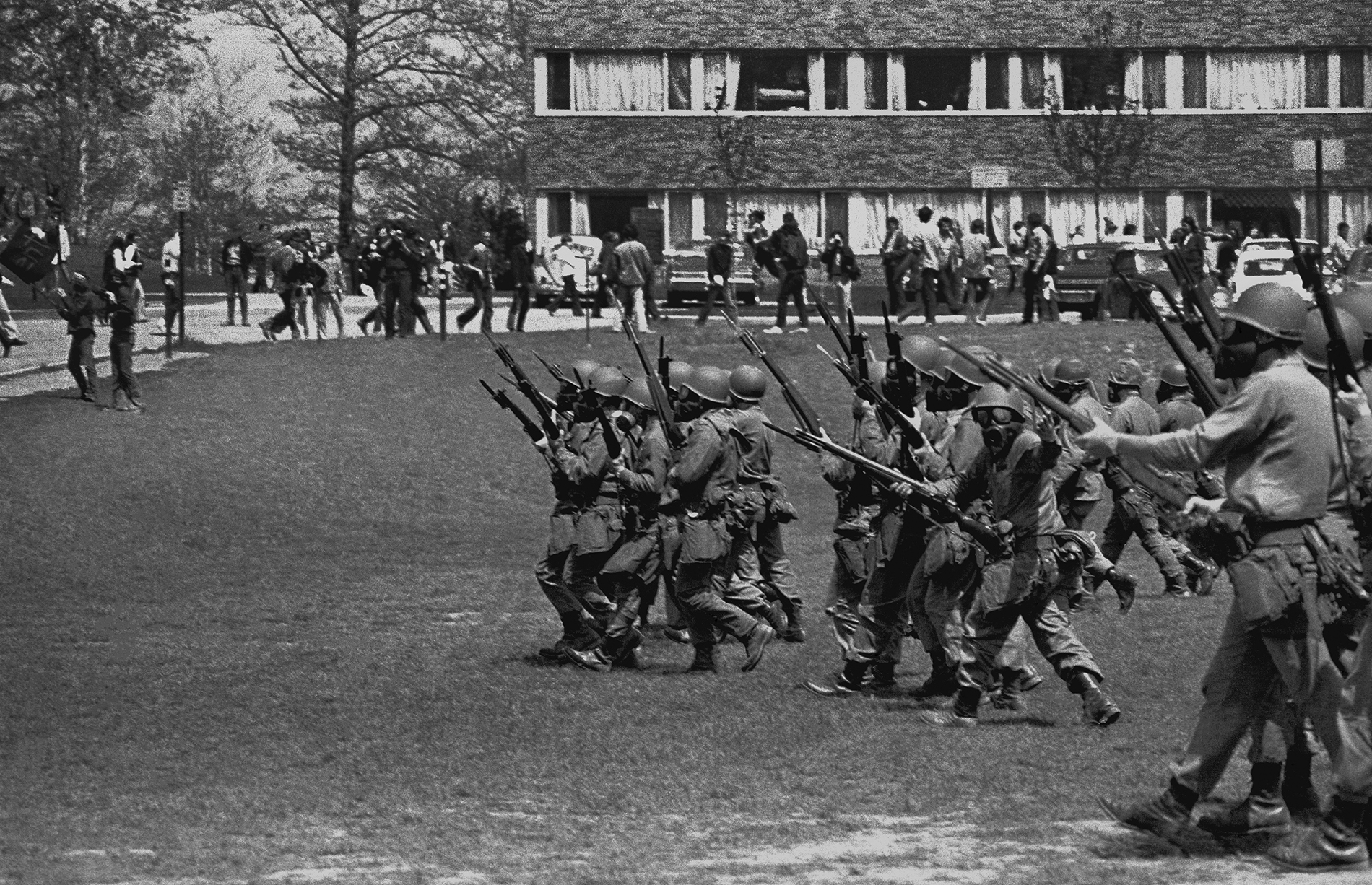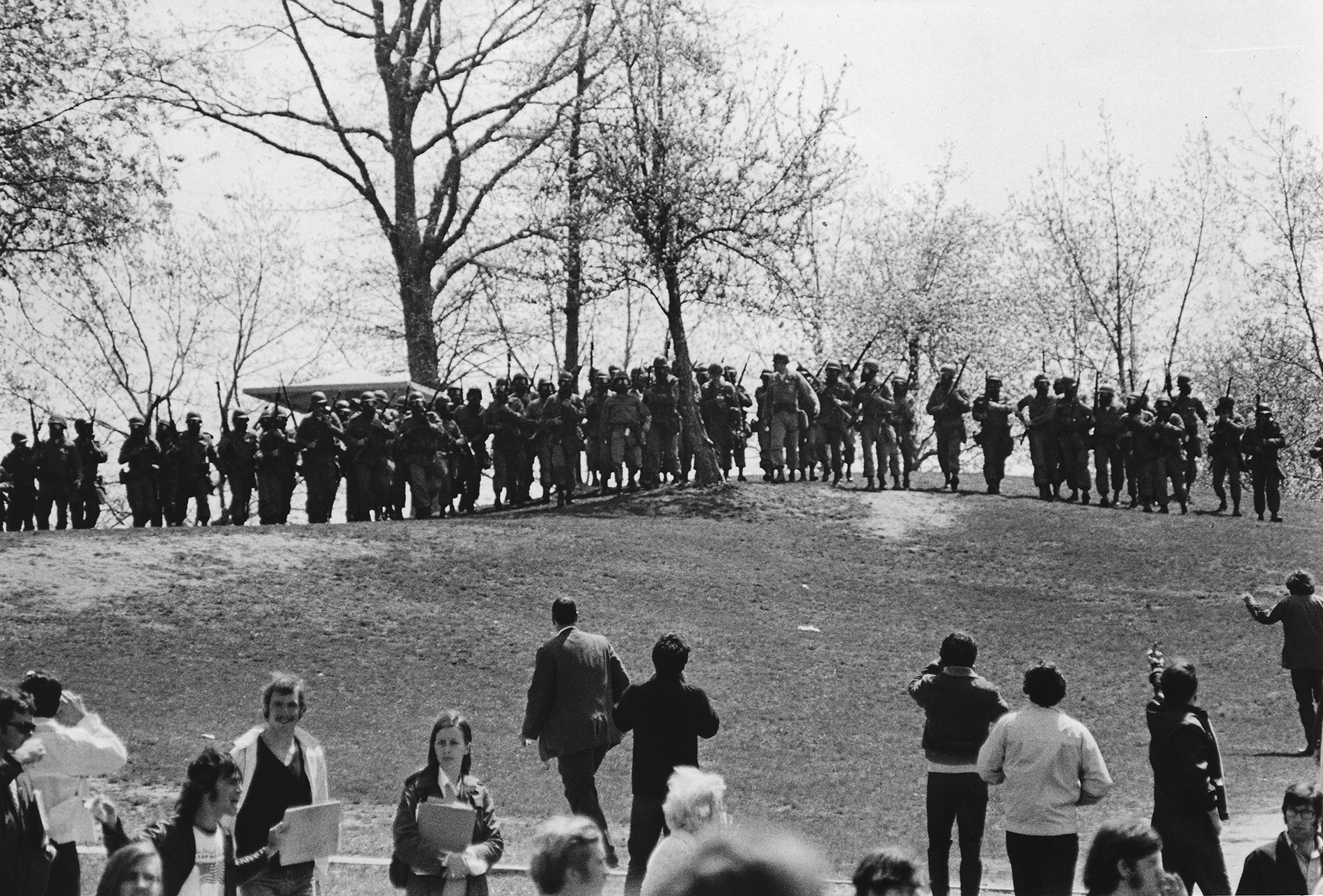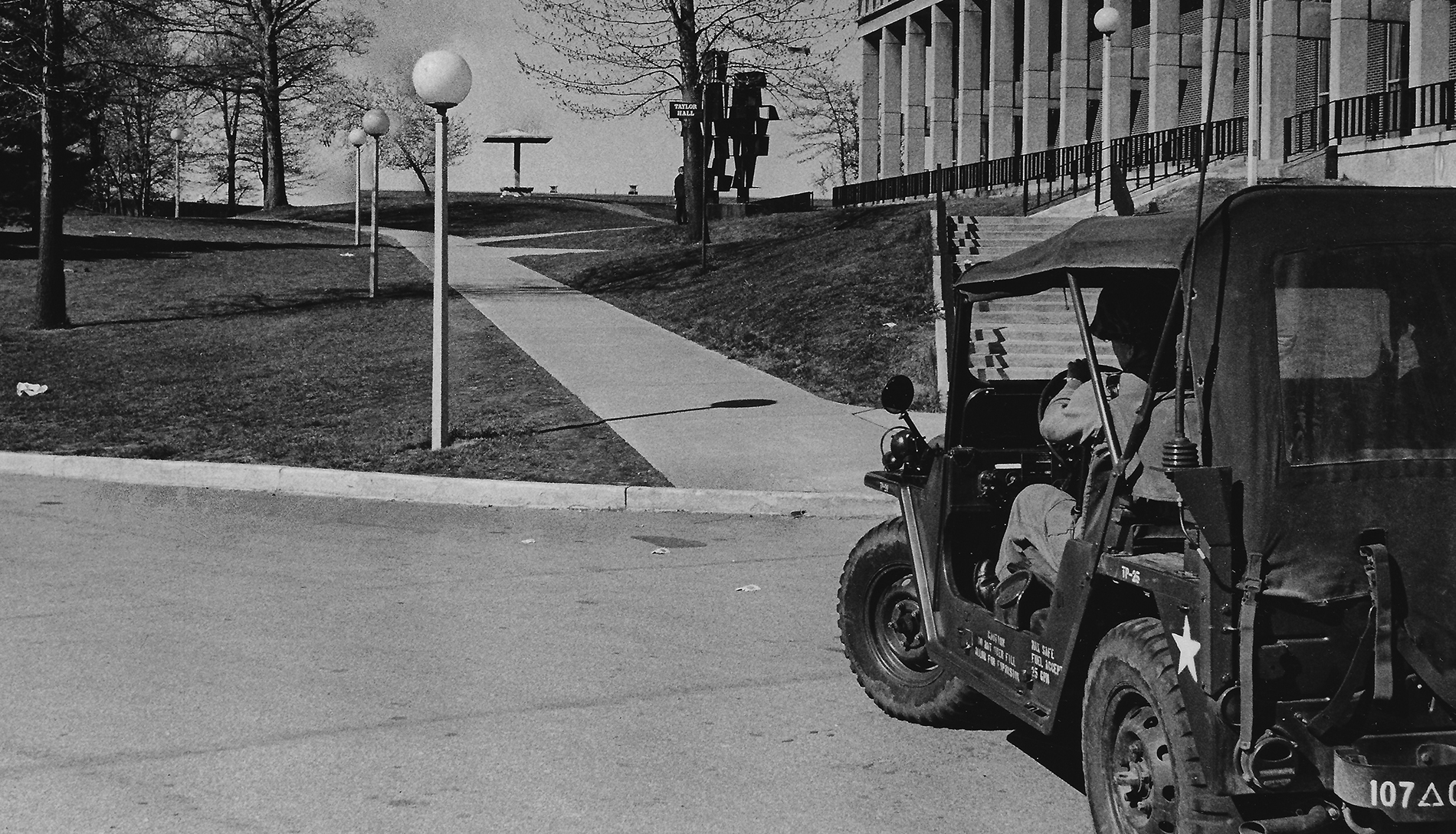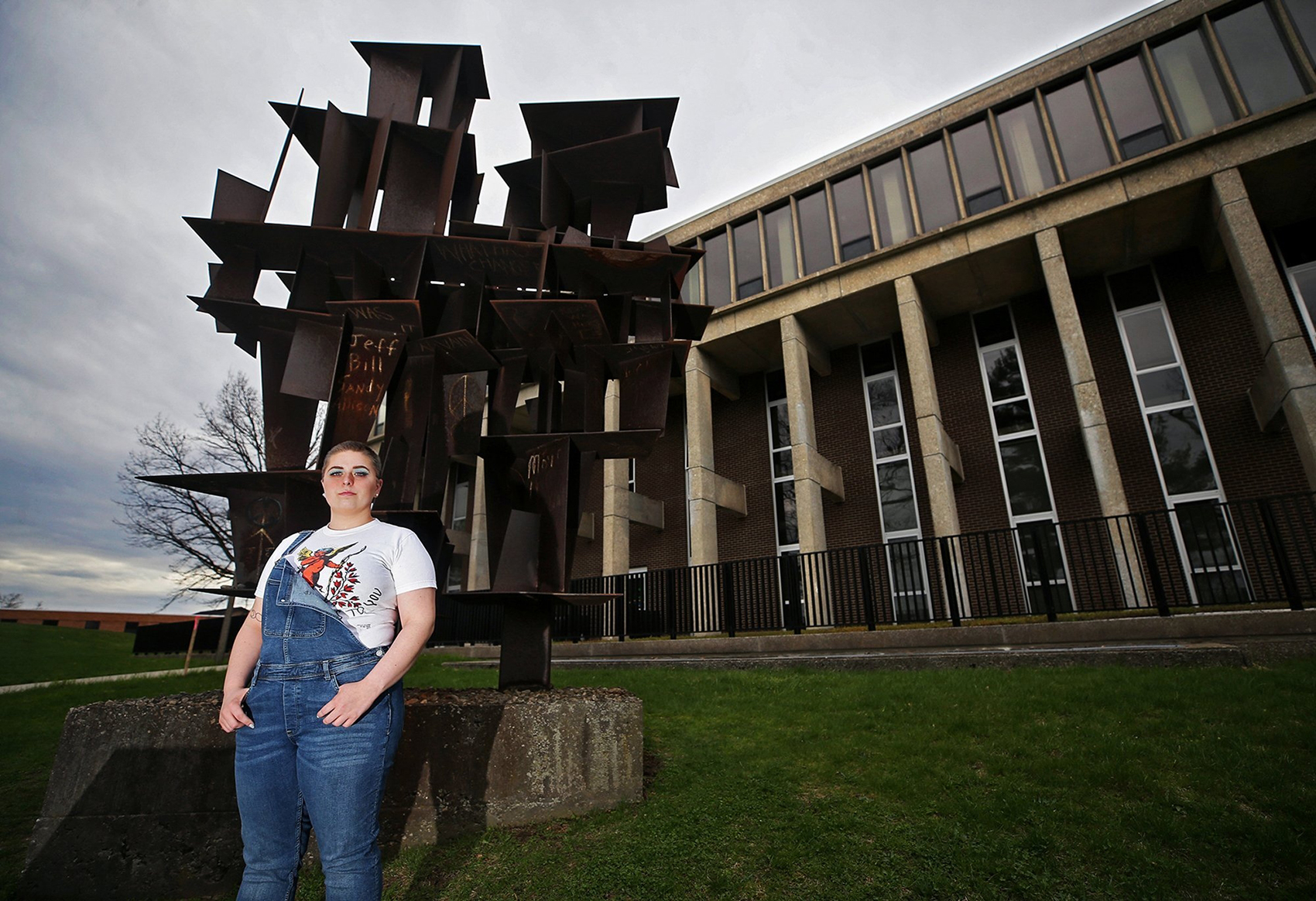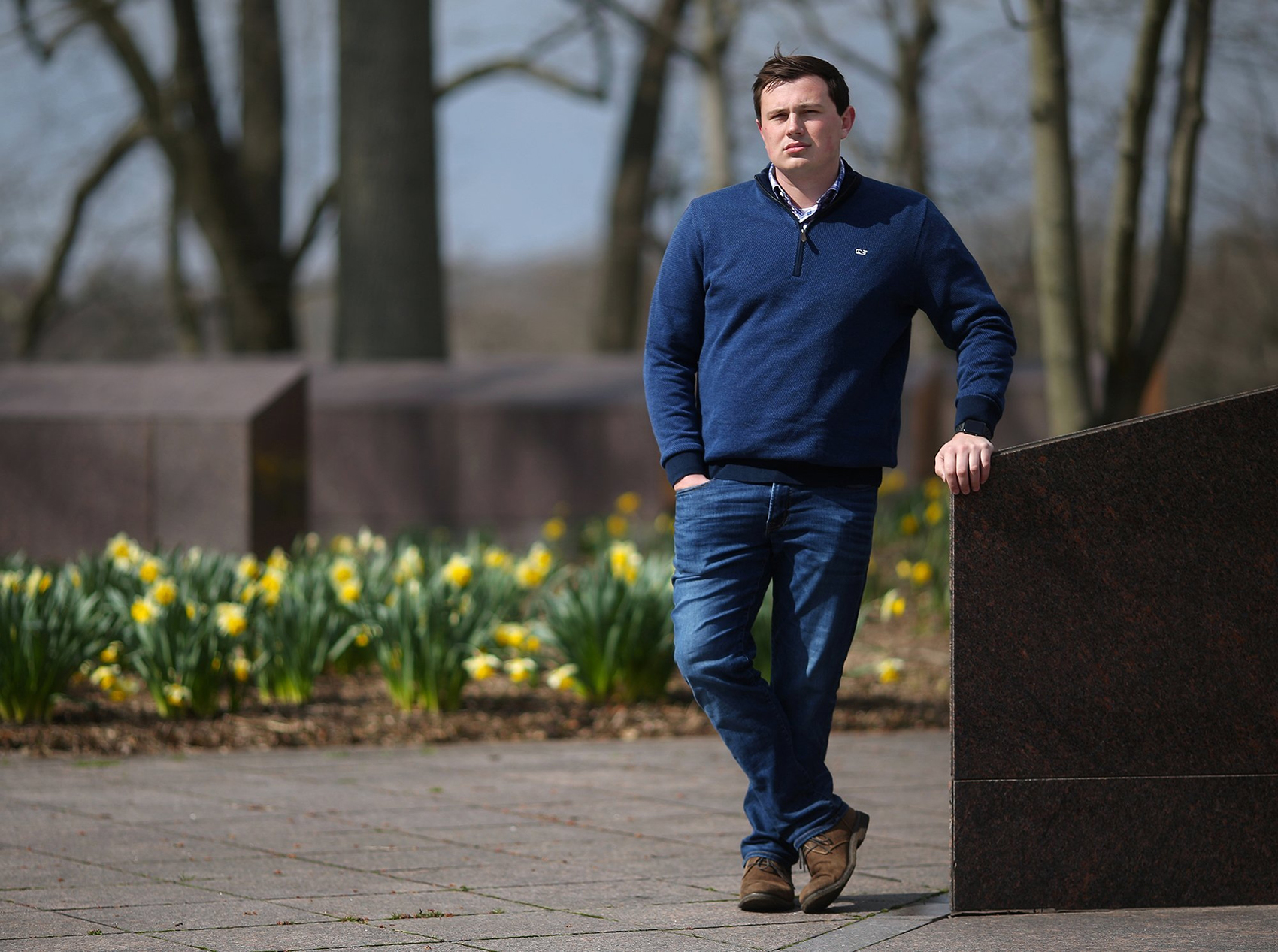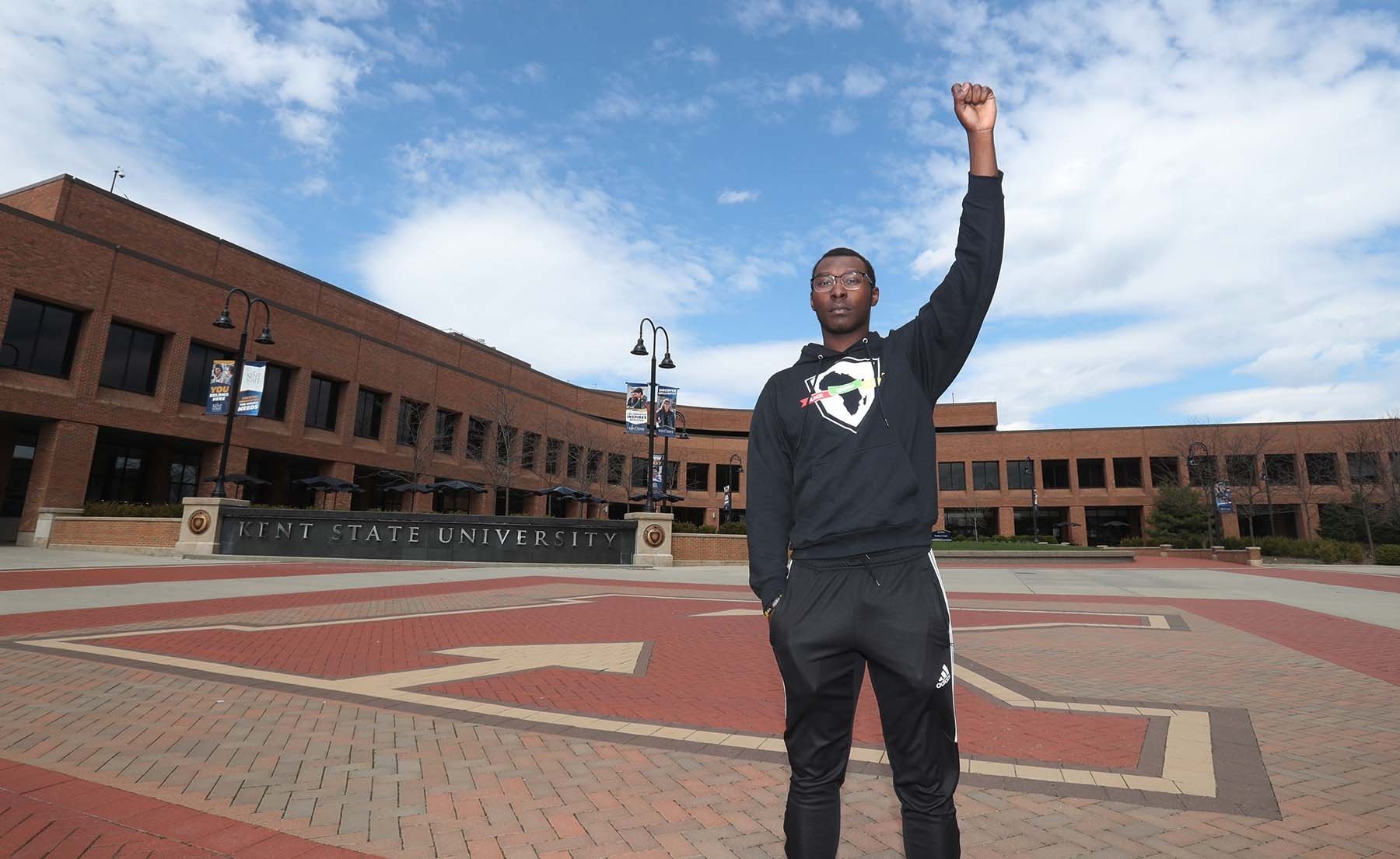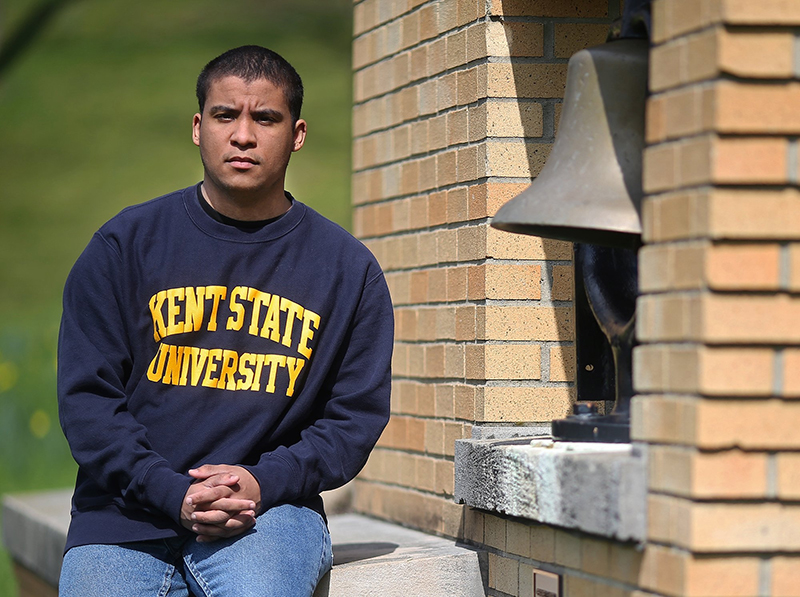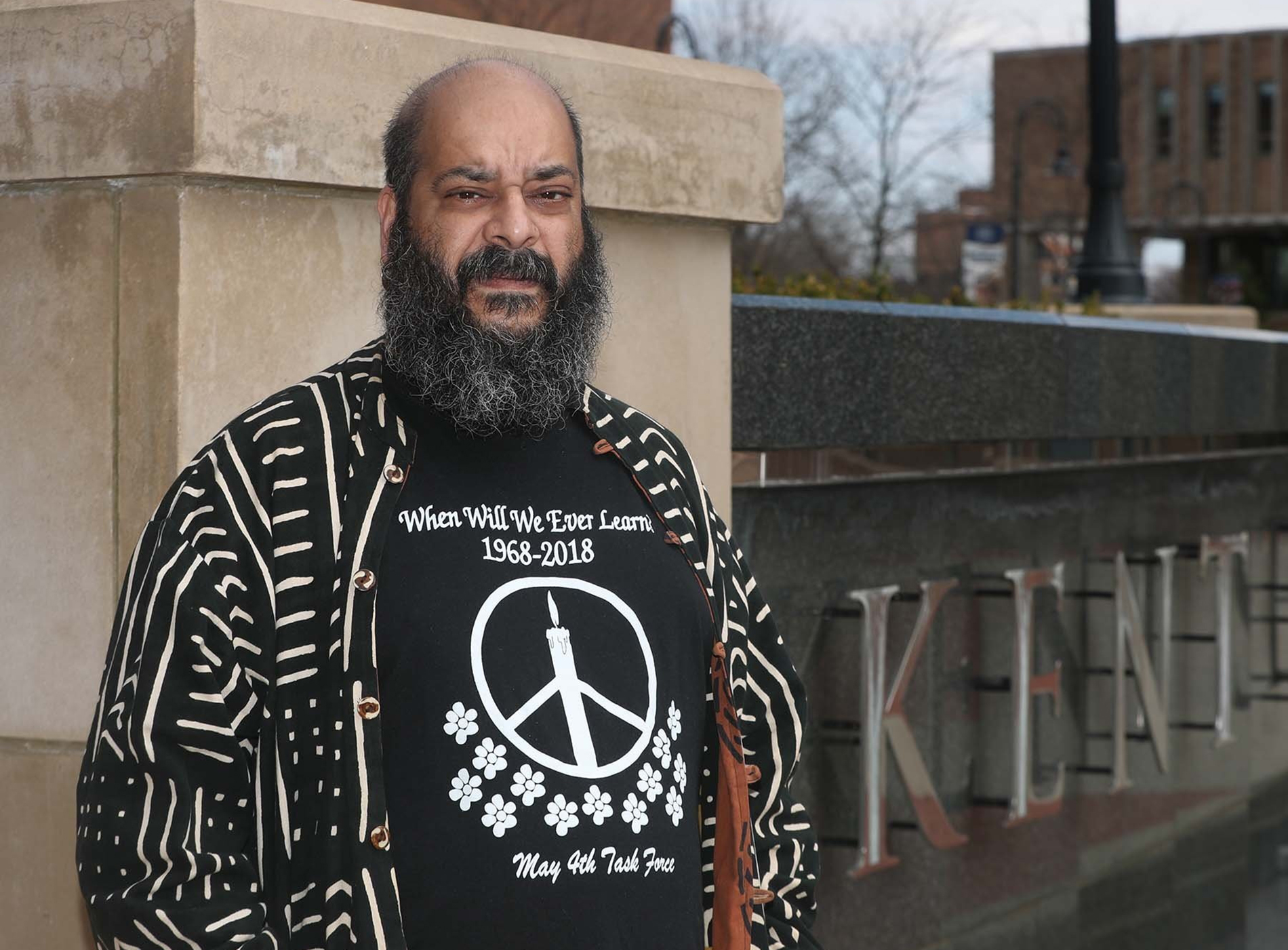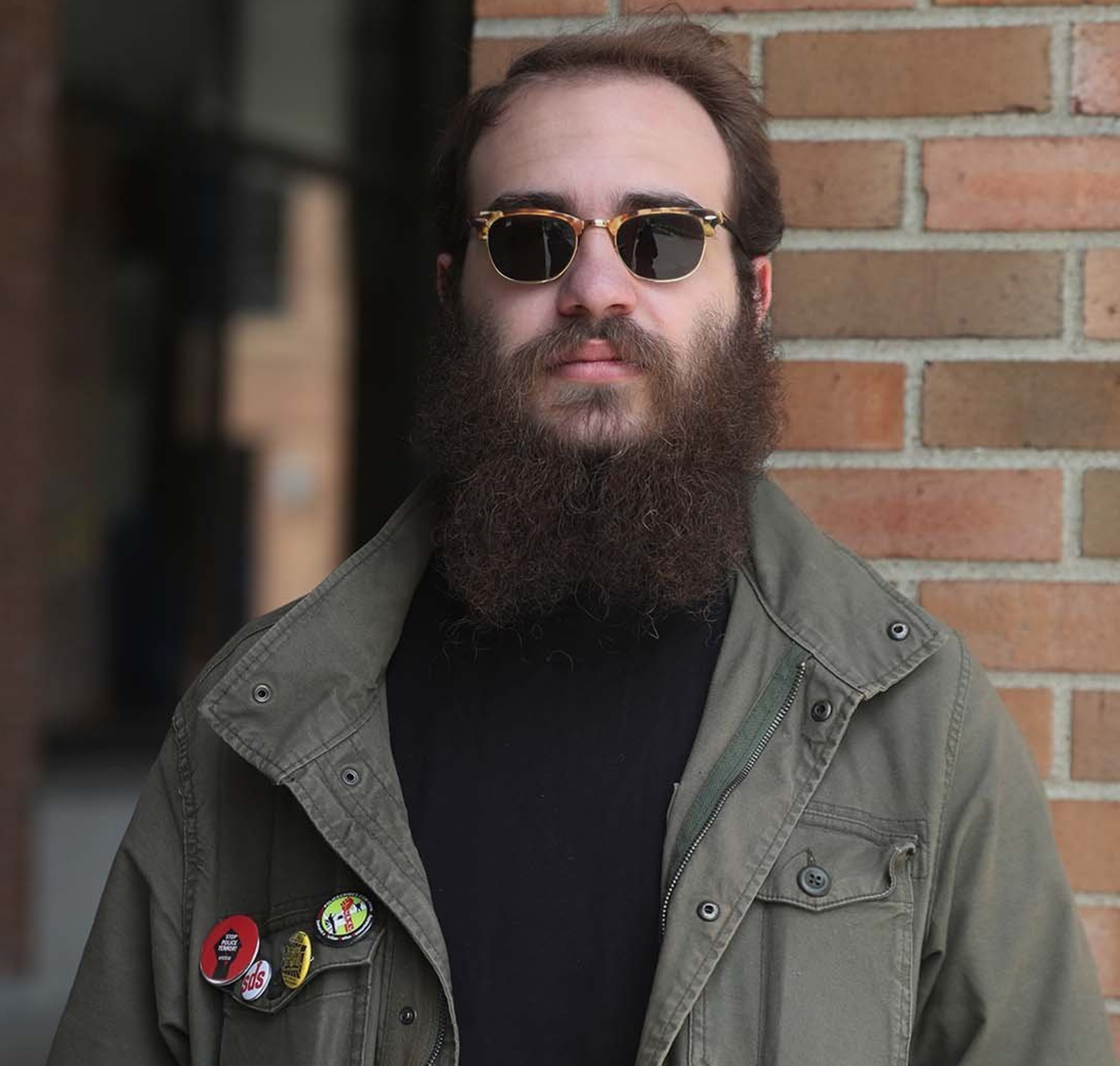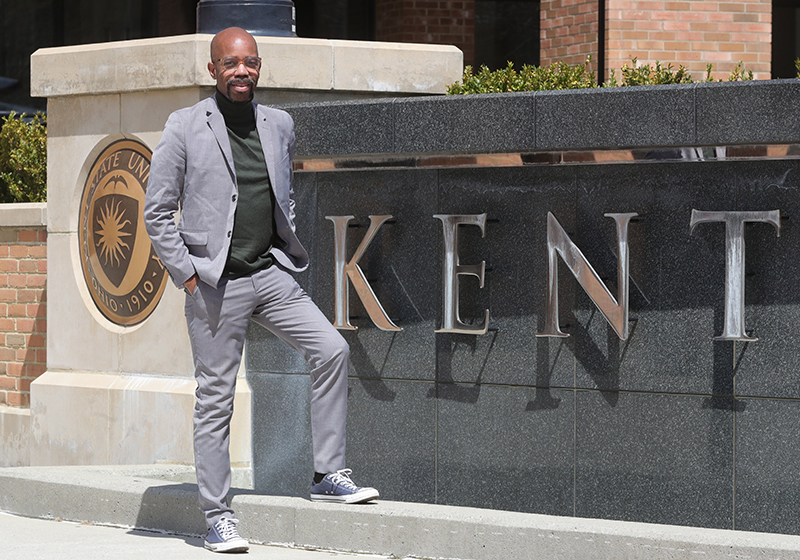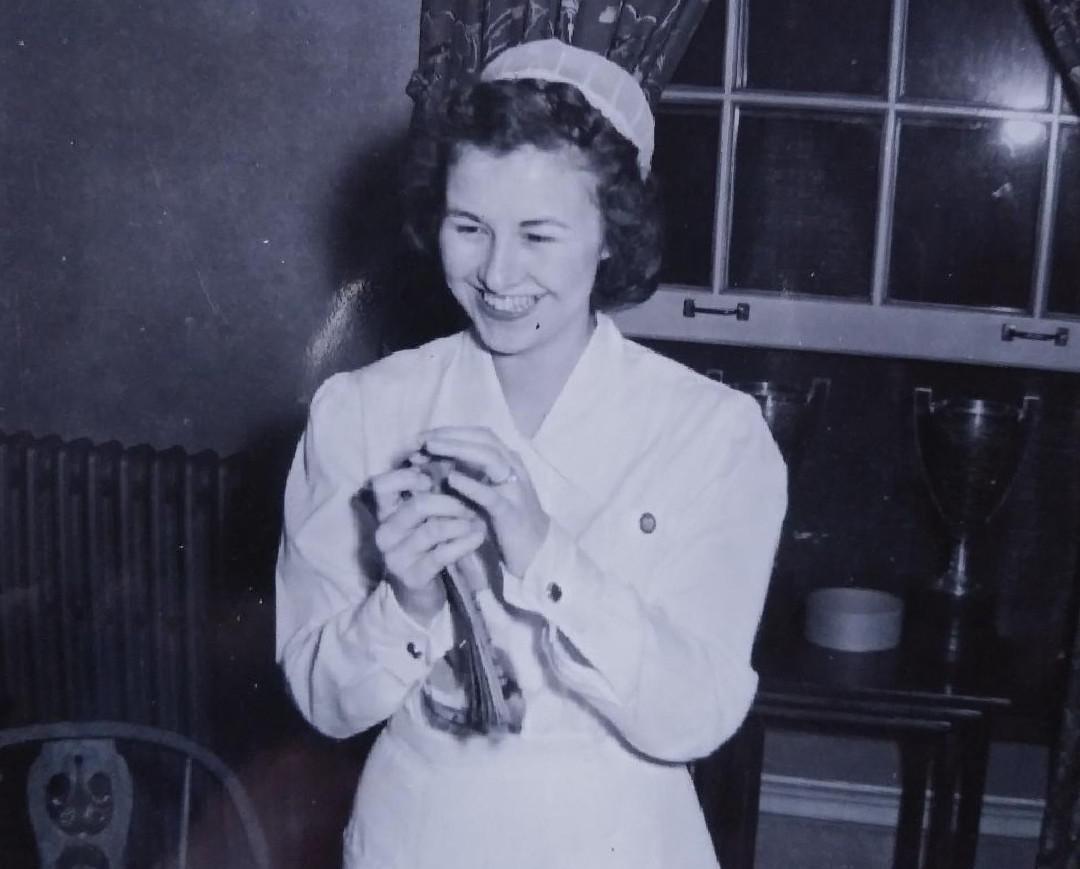How events of May 4, 1970 influence student activism today
By Emily Mills and Jennifer Pignolet, Akron Beacon Journal
May 4, 2020
In a bare-walls classroom at Kent State University, guest speaker Alan Frank leans back in an office chair, his hands clasped around the back of his head, and poses a question to 30 students.
“Let’s pick four people out of this room,” Frank says. “Who’s going to be on the ground?”
In other words: Which one of them is going to die?
The question stuns the class.
As Kent State students, they know four young people like them were killed by the Ohio National Guard on their campus during a 1970 protest opposing the invasion of Cambodia during the Vietnam War.
It was 50 years ago, but at Kent State, May 4 is a looming presence. The reminders, from memorial markers to bullet holes, are everywhere. And this elective course focuses on that day, and the days before and after that fateful Monday.
But hearing the question posed to them, forcing a mental selection of their peers in that room to die, drives the point home.
For some current Kent State students, May 4 represents a depressing point of reference they hear often when they share where they go to school. They need that push from people like Frank — who was on campus that day and whose father, Glenn Frank, was instrumental in de-escalating the crowds following the shooting — to truly feel the impact and severity of the event.
Julia Kelch, a Kent State senior in the university’s May 4 course, stands near the Don Drumm sculpture that was hit by a stray bullet during the shootings that occurred 50 years ago, Sunday, April 12, 2020, in Kent, Ohio. Jeff Lange | Akron Beacon Journal
In a generation that grew up with active shooter drills at school and heightened awareness of police violence, others need less of a reminder that young people like them could wind up dead.
But activism is still strong at Kent State, and for those who have picked up the baton — leading campus protests and letter-writing campaigns or fighting the university administration for more mental health support for students — May 4 serves as both a motivation and a stark reminder of what can happen when students speak out.
They raise their voices anyway.
‘Have we changed?’
In the days leading up to a planned gun-rights rally on Kent State’s campus two years ago, Sean Short’s mother gave her son clear instructions: “You are not to go to that.”
“Because to her mind, I was going to get shot,” said Short, a junior in the May 4 class.
He went anyway, part of a counterprotest movement at an event that, 48 years after May 4, brought campus to a halt once again.
When he arrived, Short said he saw police in riot gear and snipers on the roofs of buildings.
It was hard not to think of the events of May 4.
“That kind of made me wonder, have we changed? At all?” he said.
The protest, in the end, was “tense but peaceful,” the Akron Beacon Journal wrote at the time. Four people were arrested, but none were students.
Senior Julia Kelch, another student in the May 4 class, said she went to the open-carry walk to support the counterprotesters and soon found herself on the frontlines.
She heard someone yell to lock arms, she said, and became part of a human wall trying to stop [gun rights] protesters from walking farther into campus. She came away with bruises and crushed toes.
“There’s not a thing different that I would change, aside from maybe wearing closed-toe shoes on that day,” she said.
Lamar Hylton, who was Kent State’s dean of students at the time, said the protest was a balancing act of voice and safety and a tense moment, given the university’s history.
“I know that the perception of many, particularly students who were on campus at the time, was why are we allowing people with guns to come to our campus?” said Hylton, who is now the university’s interim vice president for student affairs. “How do you restrict that from happening at a public institution?”
Different approach
For Short and Kelch, two self-proclaimed liberal activists, the day was perhaps their most memorable moment of on-campus activism. But they have both fought in other ways for causes they support, including canvassing for liberal candidates and issues like reproductive freedom and rights for LGBTQ people.
Just like protesting students in 1970, whom President Richard Nixon referred to as “bums,” they say they still often feel their voices are dismissed.
“There is still very much that condescension of, ‘You’re just kids, you don’t know yet. Wait until you grow up, wait until you get a real job, your views will change.’ It’s annoying more than anything.”
“There is still very much that condescension of, ‘You’re just kids, you don’t know yet. Wait until you grow up, wait until you get a real job, your views will change,’ ” Kelch said. “It’s annoying more than anything.”
But it wasn’t just liberal students who had strong feelings about the presence of a well-armed militia on their campus.
Senior Seth Koellner, president of the Kent State College Republicans, is an avid supporter of gun rights. While some have argued that the Kent State students in 1970 would have fared better had they been armed, Koellner said he sees May 4 as “hands off” in the gun debate.
Seth Koellner, president of the Kent State College Republicans, stands in the May 4 Memorial outside Taylor Hall on Thursday, April 16, 2020, in Kent, Ohio. Jeff Lange | Akron Beacon Journal
He does view the event, however, as “a warning of what happens when the government gets too strong.”
The College Republicans as a group did not participate in either side of the open-carry walk. Koellner said such demonstrations are not how they prefer to do their advocacy. The group, which focuses on grassroots activism and campaigning for local and state candidates, held a panel discussion on guns with the College Democrats on campus months after the walk.
“I think we actually changed some minds during that debate more than the gun rally did, even though [the rally] received so much more attention,” Koellner said.
Black students stayed away
Senior Patrick Ferguson would have loved to participate in the counterprotest at the open-carry walk.
But as a black man, Ferguson said he already knew the consequences, aside from the possible loss of life, were steep. They included being branded with a criminal record were he to be arrested.
Ferguson, the president of Black United Students at Kent State, helped organize events at Oscar Ritchie Hall for students who wanted somewhere safe to be.
Instead of joining the throngs of people outside, they watched movies like “School Daze” and “Fire in the Heartland.”
It’s the same approach BUS, which was founded at the height of the Civil Rights Movement in 1968, took in 1970. BUS told its members to avoid campus rallies that weekend for their own safety.
Patrick Ferguson, the president of Black United Students at Kent State University, stands at the “K” on Risman Plaza where several BUS rallies have been held Saturday, April 11, 2020, in Kent, Ohio. Karen Schiely | Akron Beacon Journal
“We really did have to put students’ well-beings again at the forefront when it came to that, and they listened,” Ferguson said.
Senior Clayton Croom, a black student who is also in the Army National Guard, noted the deaths of two black students at Jackson State in Mississippi 11 days after the Kent State shootings don’t get the same attention.
“That is exactly why you don’t hear about Jackson State,” he said. “I’m telling you now: Why May 4 is so important is because four white kids got shot.”
Croom was initially reluctant to sign up for the May 4 class — it’s not like Kent State students don’t already hear about it enough, he initially felt, and he’s just as interested in current issues like climate change or refugee crises.
But his interest grew as the semester progressed. He relished the chances to debate other students and speakers on the finer points of the tragedy.
Senior Clayton Croom sits next to the Victory Bell on Thursday, April 16, 2020, in Kent, Ohio. Jeff Lange | Akron Beacon Journal
Croom said that although he believes the students “didn’t do anything besides use their First Amendment right,” he’s frustrated by people who dislike the National Guard as a whole because of May 4.
“It’s a certain section of the Guard that did it,” he said. “So don’t hate everyone.”
Communication skills
Associate Professor Idris Kabir Syed wasn’t born in 1970.
But after years of teaching about May 4, interviewing survivors, planning events and walking across the ground where students lost their lives, he feels a kind of secondhand trauma.
“I would come home and just break down in tears from the things that I had heard in the day,” Syed said.
Idris Kabir Syed, an associate professor in Kent State’s Department of Pan-African Studies and faculty adviser for Students for a Democratic Society, on the campus of Kent State University on Saturday, April 11, 2020, in Kent, Ohio. Karen Schiely | Akron Beacon Journal
He and Professor Karen Cunningham teach the May 4 class. It gives students a nuanced historical perspective while challenging them to debate what could have been done differently and to find parallels with current events and contexts.
“These are kids that have practiced active shooter drills since they were in kindergarten and elementary school,” said Syed, who teaches in the Department of Pan-African Studies. “And so for them, in many ways it’s much more real for the students than it was in 1970, many of whom could have never imagined that anyone could open fire on a college campus.”
These are kids that have practiced active shooter drills since they were in kindergarten and elementary school. And so for them, in many ways it’s much more real for the students than it was in 1970, many of whom could have never imagined that anyone could open fire on a college campus.
Syed and Cunningham have both witnessed protests on their campus that reminded them of May 4, including the open-carry walk and protests of the Iraq War in 2003.
Cunningham, who teaches in the School of Peace and Conflict Studies, tried to calm the crowd in 2003 to protect them from advancing law enforcement, just like faculty had in 1970 following the shooting.
“We were basically trying to get people out of the way, saying do not engage, they mean business and we need to kind of back away,” she said.
In their class, the professors said they don’t use the lessons of May 4 to encourage or discourage students from taking part in events like the open-carry walk or anti-war protests.
“I think over the years, we’ve learned that they are going to do what they’re going to do, much like the students of 1970,” Syed said. “What we want to encourage in them is to do whatever it is that they choose to do with as much knowledge and as much communication and conflict resolution skills as possible.”
Students’ safety
One of the biggest lessons the university learned from May 4, said Kent State’s Hylton, is the importance of student voice. He highlighted student organizations and the Kent Talks series on controversial topics as ways the university encourages civil discourse.
But there are limits on organized discourse that Hylton said are there to protect students’ safety, including limits on where they can set up information tables inside campus buildings.
Some of that may be a lingering “heightened sensitivity” in the wake of May 4, he said. “We certainly don’t want students to die or be injured trying to exercise their right to free speech.”
But the restrictions feel like an effort to “strangle” student activism, said junior Colt Hutchinson, president of Students for a Democratic Society. The group was active in the 1960s, including in the events leading up to May 4, and fell apart in the next decade but reformed in recent years.
“It’s just so challenging for student [organizations] to engage with the student body,” he said.
Colt Hutchinson, the president of Students for a Democratic Society at Kent State University, stands at the Kent Student Center, where several SDS rallies have been held, Saturday, April 11, 2020, in Kent, Ohio. Karen Schiely | Akron Beacon Journal
As the 50th anniversary of May 4 approached, Kent State students continued to find ways to make their voices heard on campus.
Earlier this year, several student organizations, including BUS and SDS, sent a list of demands to the university administration.
“We had realized that the university was not really willing to address any of these issues through a more conventional way,” said Hutchinson, a student in the May 4 class who said he came to Kent State because of its history of activism.
The demands in the eight-page letter included returning the planning of the May 4 remembrance to the students and a call to increase mental health services.
Student leaders had a few meetings with officials from the administration before the coronavirus pandemic hit the area.
Kent State University Interim Vice President for Student Affairs Lamar Hylton on Wednesday, April 22, 2020, in Kent, Ohio. Phil Masturzo | Akron Beacon Journal
“It was good headway in that we got these meetings,” said Ferguson, from BUS. “It’s just the trust in that they’re going to consistently do what they need to do.”
Hylton said although he and the university value student voice, calling Kent State a “students-first university,” students need to be realistic about how quickly changes can be made, and the university needs to help set those expectations. Systematic changes don’t happen overnight, he said.
Still, Hylton said the legacy of May 4 and its impact on student activism remain entrenched in Kent State.
Obviously on May 4 and days leading up to May 4, students were exercising their right to lend their voice to issues that they cared about. And I absolutely believe that that premise and…that engagement still rests on our community even today, 50 years later.
“Obviously on May 4 and days leading up to May 4, students were exercising their right to lend their voice to issues that they cared about,” Hylton said. “And I absolutely believe that that premise and…that engagement still rests on our community even today, 50 years later.”
Contact Beacon Journal reporters Jennifer Pignolet at jpignolet@thebeaconjournal.com and Emily Mills at emills@thebeaconjournal.com.
